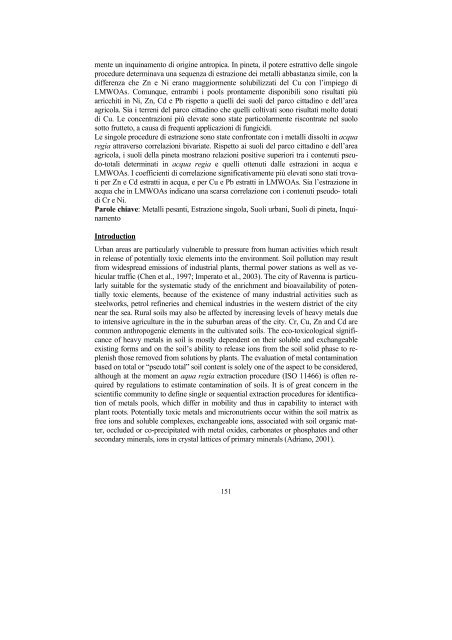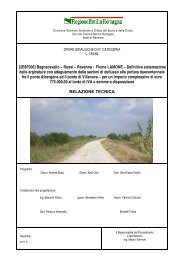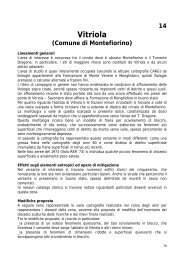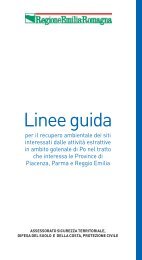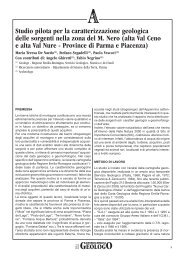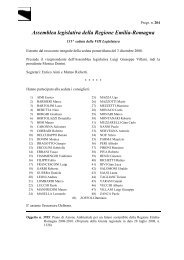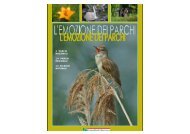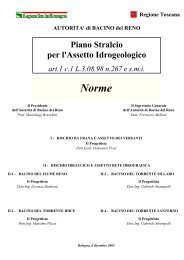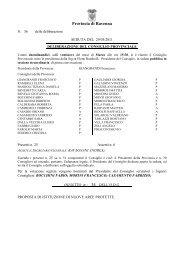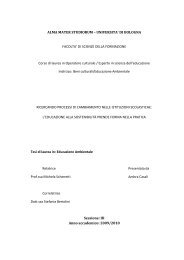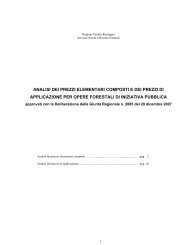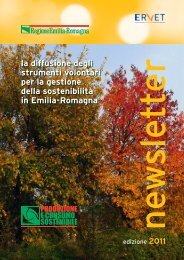air, water and soil quality qualité - ER Ambiente - Regione Emilia ...
air, water and soil quality qualité - ER Ambiente - Regione Emilia ...
air, water and soil quality qualité - ER Ambiente - Regione Emilia ...
You also want an ePaper? Increase the reach of your titles
YUMPU automatically turns print PDFs into web optimized ePapers that Google loves.
mente un inquinamento di origine antropica. In pineta, il potere estrattivo delle singole<br />
procedure determinava una sequenza di estrazione dei metalli abbastanza simile, con la<br />
differenza che Zn e Ni erano maggiormente solubilizzati del Cu con l’impiego di<br />
LMWOAs. Comunque, entrambi i pools prontamente disponibili sono risultati più<br />
arricchiti in Ni, Zn, Cd e Pb rispetto a quelli dei suoli del parco cittadino e dell’area<br />
agricola. Sia i terreni del parco cittadino che quelli coltivati sono risultati molto dotati<br />
di Cu. Le concentrazioni più elevate sono state particolarmente riscontrate nel suolo<br />
sotto frutteto, a causa di frequenti applicazioni di fungicidi.<br />
Le singole procedure di estrazione sono state confrontate con i metalli dissolti in acqua<br />
regia attraverso correlazioni bivariate. Rispetto ai suoli del parco cittadino e dell’area<br />
agricola, i suoli della pineta mostrano relazioni positive superiori tra i contenuti pseudo-totali<br />
determinati in acqua regia e quelli ottenuti dalle estrazioni in acqua e<br />
LMWOAs. I coefficienti di correlazione significativamente più elevati sono stati trovati<br />
per Zn e Cd estratti in acqua, e per Cu e Pb estratti in LMWOAs. Sia l’estrazione in<br />
acqua che in LMWOAs indicano una scarsa correlazione con i contenuti pseudo- totali<br />
di Cr e Ni.<br />
Parole chiave: Metalli pesanti, Estrazione singola, Suoli urbani, Suoli di pineta, Inquinamento<br />
Introduction<br />
Urban areas are particularly vulnerable to pressure from human activities which result<br />
in release of potentially toxic elements into the environment. Soil pollution may result<br />
from widespread emissions of industrial plants, thermal power stations as well as vehicular<br />
traffic (Chen et al., 1997; Imperato et al., 2003). The city of Ravenna is particularly<br />
suitable for the systematic study of the enrichment <strong>and</strong> bioavailability of potentially<br />
toxic elements, because of the existence of many industrial activities such as<br />
steelworks, petrol refineries <strong>and</strong> chemical industries in the western district of the city<br />
near the sea. Rural <strong>soil</strong>s may also be affected by increasing levels of heavy metals due<br />
to intensive agriculture in the in the suburban areas of the city. Cr, Cu, Zn <strong>and</strong> Cd are<br />
common anthropogenic elements in the cultivated <strong>soil</strong>s. The eco-toxicological significance<br />
of heavy metals in <strong>soil</strong> is mostly dependent on their soluble <strong>and</strong> exchangeable<br />
existing forms <strong>and</strong> on the <strong>soil</strong>’s ability to release ions from the <strong>soil</strong> solid phase to replenish<br />
those removed from solutions by plants. The evaluation of metal contamination<br />
based on total or “pseudo total” <strong>soil</strong> content is solely one of the aspect to be considered,<br />
although at the moment an aqua regia extraction procedure (ISO 11466) is often required<br />
by regulations to estimate contamination of <strong>soil</strong>s. It is of great concern in the<br />
scientific community to define single or sequential extraction procedures for identification<br />
of metals pools, which differ in mobility <strong>and</strong> thus in capability to interact with<br />
plant roots. Potentially toxic metals <strong>and</strong> micronutrients occur within the <strong>soil</strong> matrix as<br />
free ions <strong>and</strong> soluble complexes, exchangeable ions, associated with <strong>soil</strong> organic matter,<br />
occluded or co-precipitated with metal oxides, carbonates or phosphates <strong>and</strong> other<br />
secondary minerals, ions in crystal lattices of primary minerals (Adriano, 2001).<br />
151


